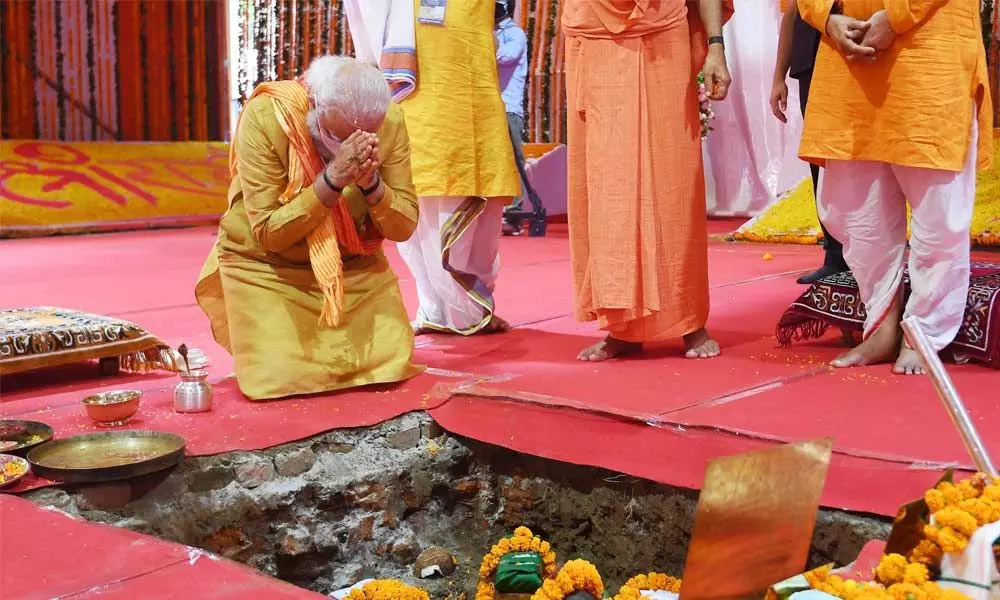Ayodhya, Amaravati, holy water and mud

Narendra Modi in Ayodhya
August 5 is certainly a historic day as the long-cherished dream of the majority of people of India who wanted to see a grand temple of Lord Rama at Ayodhya would soon become a reality
August 5 is certainly a historic day as the long-cherished dream of the majority of people of India who wanted to see a grand temple of Lord Rama at Ayodhya would soon become a reality. Of course, this issue had been mired in several controversies for the past three decades and witnessed a long-drawn battle. It was also the main agenda on which the BJP fought several elections and is likely to be used by the BJP during the next elections as well.
The positive sign in this matter is that the minorities who fought legal battle finally decided to accept the decision of the apex court. A Muslim leader of Fizabad, who was one of the main contestants against the construction of temple on the land where Babri Masjid was demolished showed magnanimity by accepting the invitation for the foundation stone ceremony and said that perhaps Lord Rama himself wanted him to participate in it. This indicates the unity in diversity and the bonding between the people of the country.
There has also been an unnecessary controversy that the Prime Minister should not go for laying foundation stone. No one questions if a Prime Minister or a Chief Minister participates in Christmas celebrations or attends Iftar parties or even host Iftar parties. That is called secularism. But if he goes to lay foundation stone for a Hindu temple, he becomes communal. This is rather unfortunate. Why can't political parties and leaders feel that this could usher in a new chapter and ensure greater bonding between the Hindus and Muslims and become another step towards territorial integrity of nation. It is not Modi as individual who has gone to lay the foundation stone, but it is the Prime Minister of India. The objections raised by politicians against Modi's foundation stone is nothing but pseudo secularism.
As part of Hindu tradition, water and earth was collected from the "thousands of holy rivers and shrines" across the country. The earth and water came from Nagpur, the birthplace of the Rashtriya Swayamsevak Sangh (RSS); from Kashi, the birthplace of Sant Ravidasji; the Maharshi Valmiki Ashram at Sitamarhi, Bihar; Kachargad in Gondia District in Vidarbha (Maharashtra); Ramrekhadham of Jharkhand; Tantya Bheel's holy land in Madhya Pradesh; Shri Harmandir Sahib (Golden Temple) of Amritsar; Mhow, the birthplace of Dr Babasaheb Ambedkar; the Jain Lal Mandir in Delhi and the Valmiki Temple in Delhi, where Mahatma Gandhi lived for 72 days.
There is also a controversy over the Muhurtam for laying foundation stone. It is said that on Wednesday there is no Abhijit Lagnam. While it is certainly a matter for celebration, one also needs to ponder over the rituals like carrying holy water and mud. Is it just a matter of ritual or does it have any sanctity? Does it purify the land where it is sprinkled? This question arises because similar exercise was made regarding Amravati as well.
Soil and water from 16,000 villages in the State and prominent pilgrim centres in the country were brought to the capital region to be used in the construction of the capital city. The idea is to promote a sense of belongingness among the people, it was claimed. It was the same Narendra Modi who laid the foundation stone for the new capital of Andhra Pradesh at Uddandarayunipalem village in Guntur district. Modi said this symbolism had the message that Delhi would be working with AP at every step to make sure the growth of the capital and State takes place properly.
Amaravati will be a benchmark for the development of new cities. Andhra Pradesh is taking up a new initiative on Vijaya Dasami of building a new capital at the place where in history it commanded respect for its culture. Though Modi said Amaravati was truly people's capital, the issue has now landed into legal controversies and the fate of about 30,000 farmers is hanging in balance. The only difference between Ayodhya and Amaravati is that the legal complications regarding Ayodhya are over while Amaravati farmers are still fighting for their rights.



















